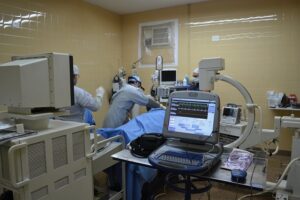How Immunocompromised Patients Are at Risk for ARDS
Understanding the Risk of ARDS in Immunocompromised Patients
Acute Respiratory Distress Syndrome (ARDS) is a serious and often life-threatening condition that severely affects lung function. It typically occurs as a response to various forms of injury to the lung, including infections, trauma, or inhalation of harmful substances. For immunocompromised patients—those with weakened immune systems due to conditions such as cancer, HIV/AIDS, organ transplants, or long-term use of immunosuppressive medications—this risk is notably heightened. Understanding the mechanisms behind ARDS and how immunocompromised individuals are particularly susceptible can empower those affected and their loved ones to take proactive steps towards managing their health.
What is ARDS?
Acute Respiratory Distress Syndrome is characterized by sudden and severe inflammation of the lungs, which leads to a significant decrease in oxygen levels in the bloodstream. The condition may arise due to several underlying health issues, but the common threads include lung injury and inflammation. In a healthy individual, the lung’s alveolar-capillary membrane allows for efficient gas exchange, but in ARDS, this membrane becomes significantly impaired.
ARDS can manifest in two primary forms:
- Exogenous ARDS: Triggered by external factors such as pneumonia, sepsis, or toxic exposure.
- Endogenous ARDS: Related to internal physiological responses, such as severe trauma or shock.
This syndrome presents symptoms that include severe dyspnea (difficulty breathing), anxiety, and reduced blood oxygen levels, which can quickly escalate into serious complications if not treated promptly. Early recognition and intervention are crucial, particularly for at-risk populations, including those who are immunocompromised.
Why Are Immunocompromised Patients at Higher Risk for ARDS?
Immunocompromised patients face increased susceptibility to infections, inflammatory responses, and complications from pre-existing conditions—all key contributors to ARDS development. Their weakened immune systems may not effectively tackle infections that could lead to lung damage, thereby increasing the likelihood of acute inflammation and respiratory failure.
Several factors contribute to this heightened risk:
- Increased infection rates: Immunocompromised patients frequently experience recurrent infections—particularly respiratory infections—which can instigate ARDS.
- Chronic lung conditions: Conditions like chronic obstructive pulmonary disease (COPD) or asthma, which are more prevalent in some immunocompromised groups, may predispose patients to greater lung injury.
- Impact of treatments: Many individuals undergoing cancer treatments, such as chemotherapy, may develop additional complications that can further compromise lung function.
Common Causes of ARDS in Immunocompromised Patients
While ARDS can result from various underlying causes, some are significantly more prevalent among immunocompromised individuals. Understanding these causes can help in monitoring and mitigating the risk:
- Pneumonia: Pulmonary infections are one of the leading causes of ARDS in immunocompromised patients. The inability to fight off bacteria or viruses leads to infection that can quickly escalate into a severe inflammatory response.
- Sepsis: A systemic inflammatory response to infection, sepsis is particularly dangerous for immunocompromised individuals as it can lead to multi-organ failure, including the lungs.
- Transfusion-related acute lung injury (TRALI): Patients who receive blood transfusions may be at risk for TRALI, an immune-mediated reaction that can result in ARDS.
Taking precautionary measures, including vaccinations and timely medical interventions, can play a pivotal role in reducing the incidence of these potential triggers.
Signs and Symptoms of ARDS
Awareness of the symptoms of ARDS is especially important for immunocompromised patients and their caregivers. Early identification of these signs can facilitate important interventions before the condition progresses severely. Common symptoms include:
- Sudden onset of shortness of breath: This may occur within hours or days after an inciting injury or infection.
- Rapid, shallow breathing: Patients may exhibit an increased respiratory rate as their body attempts to compensate for decreased oxygen levels.
- Coughing and increased respiratory distress: Alongside other symptoms, patients may begin to cough, and show signs of anxiety or panic due to difficulty in breathing.
Recognizing these symptoms quickly allows for prompt medical evaluation and management, which can mitigate potentially serious complications. Immunocompromised individuals should have a healthcare provider readily available for consultation if any of these signs arise.
Diagnosis of ARDS
Once symptoms of ARDS are noted, a thorough medical evaluation is crucial for diagnosis. The diagnostic criteria typically include:
- Clinical history and physical examination: Physicians will assess the patient’s overall health, prior history of infections, and existing comorbidities.
- Imaging studies: Chest X-rays or CT scans can reveal the extent of lung involvement and help differentiate ARDS from other conditions.
- Blood tests: These tests can help determine levels of oxygen in the bloodstream, alongside indicators of infection or inflammation.
It’s critical for immunocompromised individuals to recognize that their unique health profiles may require a different diagnostic approach. Open communication with healthcare providers about symptoms and potential risk factors is essential.
Management and Treatment of ARDS
The management strategies for ARDS can be complex, especially in immunocompromised patients who may have additional health concerns. Treatment typically focuses on the underlying cause of ARDS while supporting lung function. Key management strategies include:
- Mechanical ventilation: In severe cases, patients may require assistance with breathing through mechanical ventilation to ensure oxygen delivery.
- Antibiotic or antiviral therapy: If the cause of ARDS is determined to be an infection, appropriate pharmacologic interventions are crucial.
- Fluid management: Careful administration of fluids can help prevent fluid overload, a common issue in ARDS patients.
A multi-disciplinary approach involving critical care specialists, pulmonologists, and infectious disease experts is often beneficial in crafting an appropriate treatment plan tailored to the patient’s specific needs.
Preventive Strategies for Immunocompromised Patients
Since immunocompromised individuals are at a significantly higher risk for ARDS, proactive measures play a critical role in prevention. Some strategies that can be effective include:
- Vaccination: Keeping up with vaccinations, such as the flu and pneumococcal vaccine, can reduce the risk of respiratory infections that lead to ARDS.
- Infection control measures: Hand hygiene, wearing masks in crowded places, and avoiding exposure to sick individuals are foundational to minimizing infection risk.
- Regular medical assessments: Routine health check-ups and communication with healthcare providers regarding any new symptoms can facilitate early intervention.
Utilizing these strategies can significantly mitigate the threat of infections spilling over into ARDS and overall respiratory complications.
FAQs about ARDS and Immunocompromised Patients
1. What is the prognosis for ARDS in immunocompromised patients?
The prognosis can vary widely depending on the cause of ARDS, the specific patient’s health background, and the timeliness of treatment. Generally, prompt treatment leads to better outcomes.
2. Are all immunocompromised patients equally at risk for ARDS?
No, the risk varies based on several factors including the degree of immunocompromise, underlying health conditions, and pre-existing lung disease.
3. Can ARDS be prevented entirely?
While it may not be entirely preventable, its risks can be significantly minimized through vaccination, infection control practices, and close monitoring of health.
4. How can family members of immunocompromised patients support them?
Family members can advocate for health monitoring, help implement prevention strategies, and provide emotional support in times of stress.
Conclusion
The heightened risk of ARDS among immunocompromised patients highlights the need for vigilance in both prevention and treatment. Understanding the underlying mechanisms, recognizing symptoms, and utilizing effective management strategies can make a substantial difference in outcomes. In today’s ever-changing healthcare landscape, collaborative efforts involving patients, families, and healthcare teams are essential to ensuring safer health experiences for those at risk. Continued education and compassionate engagement with healthcare resources can empower immunocompromised patients to navigate their unique health challenges successfully.
For further information, please refer to reputable medical sources and articles, such as those from the American Thoracic Society or peer-reviewed journals on critical care medicine.
About ARDS and Post-ARDS
ARDS (Acute Respiratory Distress Syndrome) is a life-threatening condition typically treated in an Intensive Care Unit (ICU). While ARDS itself is addressed during the ICU stay, recovery doesn’t end with discharge; patients then embark on a journey of healing from the effects of having had ARDS.
Disclaimer
The information provided in ARDS Alliance articles is for general informational and educational purposes only and is not a substitute for professional medical advice, diagnosis, or treatment. While we strive to present accurate, current information, the field of Acute Respiratory Distress Syndrome (ARDS) and related healthcare practices evolve rapidly, and ARDS Alliance makes no guarantee regarding the completeness, reliability, or suitability of the content.
Always seek the advice of qualified healthcare professionals with any questions you may have regarding a medical condition. Never disregard professional medical advice or delay seeking it because of information you read in ARDS Alliance articles. ARDS Alliance, its authors, contributors, and partners are not liable for any decision made or action taken based on the information provided in these articles.
About ARDS Alliance
Our mission is to improve the quality of life for ALL those affected by ARDS.
The ARDS Alliance is a non-profit committed to raising awareness and enhancing the understanding of Acute Respiratory Distress Syndrome (ARDS), a severe lung condition often occurring in critically ill patients. Through developing alliances, it unites various organizations and experts striving to improve care and support research aimed at finding more effective treatments. Their efforts include educating the public and healthcare providers about ARDS symptoms, risk factors, and advancements in treatment, ensuring better patient outcomes and resource availability.

“As the President of ARDS Alliance, I am dedicated to improving the lives of patients suffering from acute respiratory distress syndrome. Through our advocacy efforts and partnerships with medical professionals, we strive to raise awareness and support research for better treatment options. Together, we can make a difference in the fight against ARDS.”
~ Paula Blonski
President, ARDS Alliance





